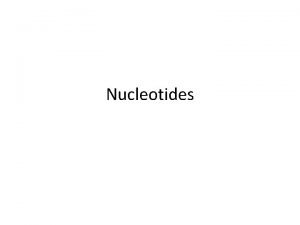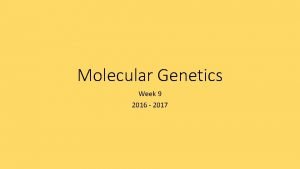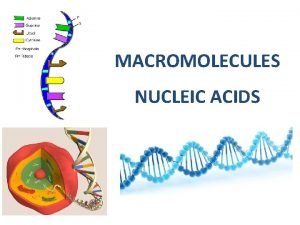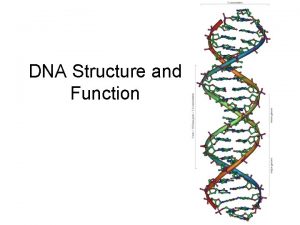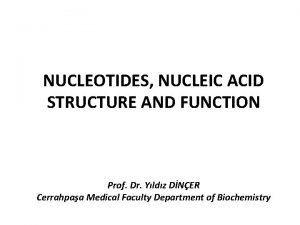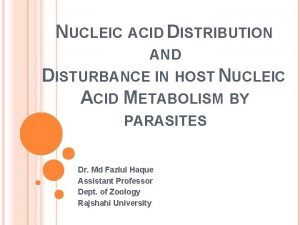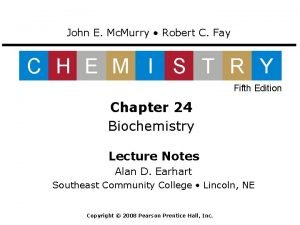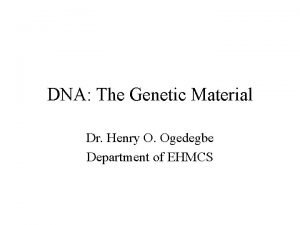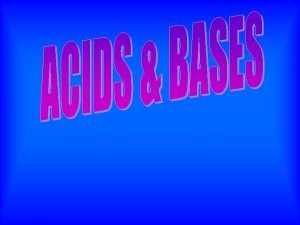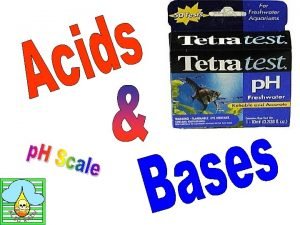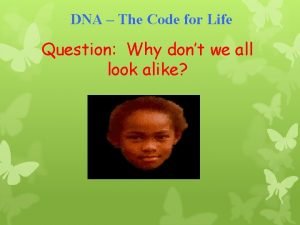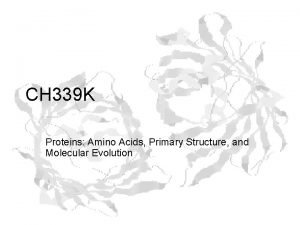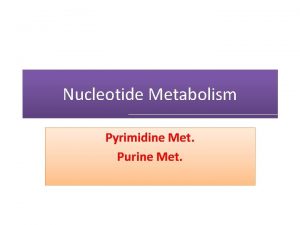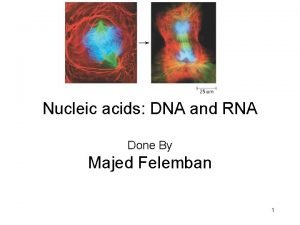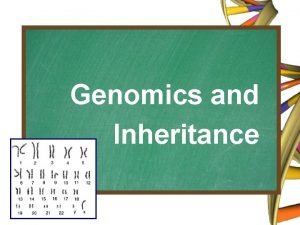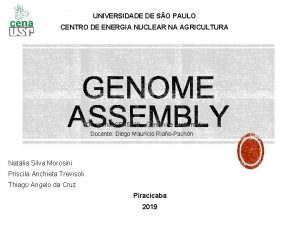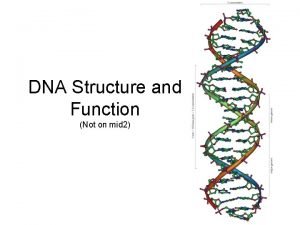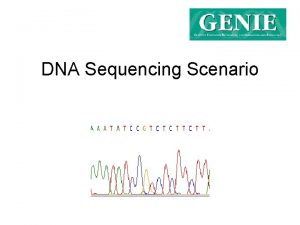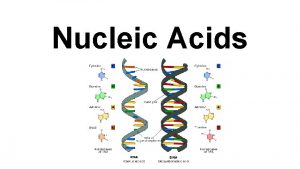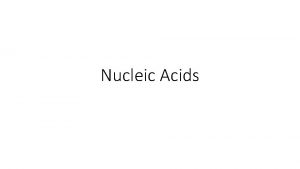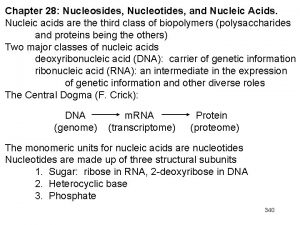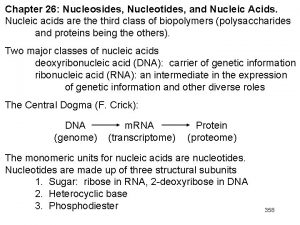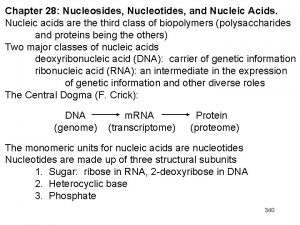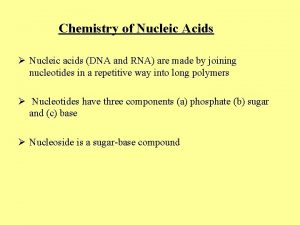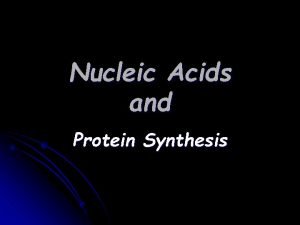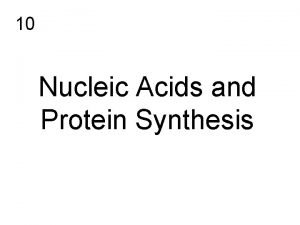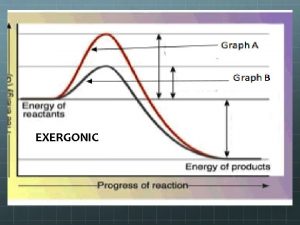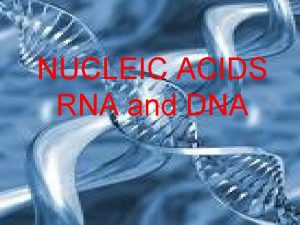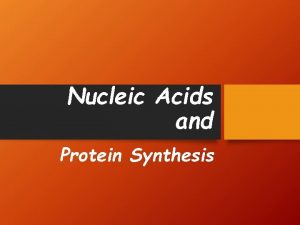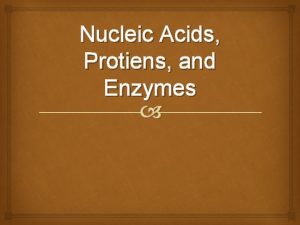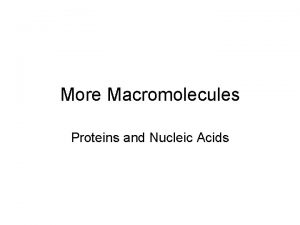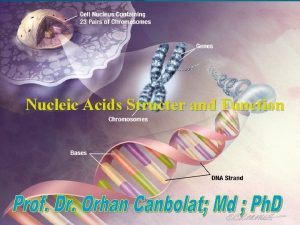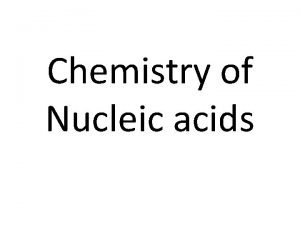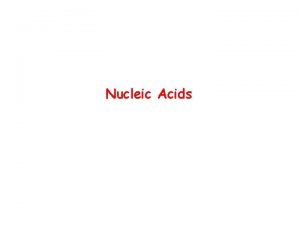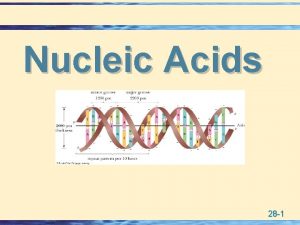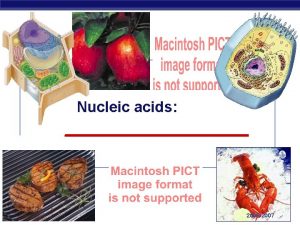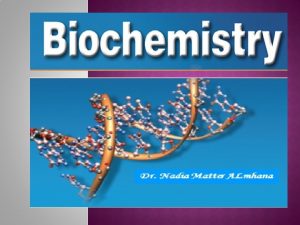Nucleotides and nucleic acids Nucleotides have three parts





























- Slides: 29

Nucleotides and nucleic acids

Nucleotides have three parts Phosphate group Monosaccharide D-ribose nitrogenous base

D-ribose or 2 -deoxy-D-ribose 5’ 1’ 4’ 3’ 2’ deoxy-ribonucleic acid DNA ribonucleic acid RNA

Nitrogenous bases Pyrimidines Purines adenine (A) guanine (G) cytosine (C) thymine (T) uracil (U)

Nucleoside = sugar + base linked by β-glycosidic bond at the 1’ anomeric carbon Adenosin 2 -deoxyadenosine

Phosphate + Nucleoside = Nucleotide 5’ adenosine triphosphate (ATP) cyclic adenosine monophosphate (AMP)

Nucleotides and Nucleic Acids NH 2 Nucleotides -O OP O - O Phosphate -O Adenine OP O O CH 2 O Ribose Adenosine monophosphate (AMP)

Nucleotides and Nucleic Acids NH 2 Nucleotide diphosphate: -O O- Adenine O- P O O O CH 2 O Ribose Adenosine diphosphate (ADP)

Nucleotides and Nucleic Acids NH 2 Nucleotide diphosphate: -O OP O - O Phosphate -O O- Adenine O- P O O O CH 2 O Ribose Adenosine diphosphate (ADP)

Nucleotides and Nucleic Acids NH 2 Nucleotide triphosphate: -O O- O- Adenine O- P O P O O CH 2 O Ribose Adenosine tr. Iphosphate (ATP)

Nucleotides and Nucleic Acids NH 2 Nucleotide triphosphate: -O O- O- O- P O P O O O Energy Unit Adenine O CH 2 O Ribose Adenosine tr. Iphosphate (ATP)

Nucleotides and Nucleic Acids NH 2 Nucleotide diphosphate: -O OP O - O Phosphate Negative Charge -O O- Adenine O- P O O O CH 2 O Ribose Adenosine diphosphate (ADP) Negative Charge

Electrophoresis is based on the molecules charge

Nucleic Acids Nucleic acid polymers contain nucleotides connected by phosphate esters Connects the 3’ hydroxyl of one ribose to the 5’ hydroxyl of another 3’ 5’

Bases vary according to the order of the nucleosides Backbone made up of ribose and phosphate groups We can list the sequence of bases

Frequency of bases in human DNA • adenine (A) = 30 % • thymine (T) = 30 % • cytosine (C) = 20 % • guanine (G) = 20 % WHY? DNA must be two strands DNA must be complementary

AT pairs makes two hydrogen bonds GC pairs makes three hydrogen bonds

AC pairing and GT pairing make repulsive instead of attractive interactions

Nucleotides and Nucleic Acids Rosalin Franklin 1952: x-ray of DNA suggested helical twisted shape

Nucleotides and Nucleic Acids Watson and Crick 1953 Used Rosalind Franklin's x-ray diffraction photo of DNA to identify DNA structure. Movie: Photo 51

DNA molecule contains millions of base pairs One strand is a complementary to the other antiparallel strands 5’ 3’ 3’ 5’

DNA T G C T A C G A T A G G A T G C T A Base pairs

DNA T G C T A C G A T G C T A Base pairs

DNA Sequence: TGCTACGAT Base pairs

Structural variation in DNA • B-DNA – Most commonly occurring • Z-DNA – Helix winds to the left in a zigzag pattern • A-DNA – Shorter, more compact – Favored in water-poor environments

Others • Triplex DNA – Transient molecule – Has been implicated in the regulation of several genes • G-quadruplex – quadruple-stranded structures formed by a guanine-rich sequences of nucleic acids

ribose deoxyribose


RNA forms structures • RNA has structure variation due to not having limitations of stereochemistry • RNA structure influences gene expression • Critical roles in processes --- ligand sensing, regulation of translation, polyadenylation, splicing
 Biomedical importance of nucleotides
Biomedical importance of nucleotides Hystonia
Hystonia What is an anticodon
What is an anticodon Nucleic acid monomer
Nucleic acid monomer Polymer structure of nucleic acids
Polymer structure of nucleic acids Nucleic acid function
Nucleic acid function Ribonucleotide vs deoxyribonucleotide
Ribonucleotide vs deoxyribonucleotide Nucleotide vs nucleoside
Nucleotide vs nucleoside Function of nucleotides
Function of nucleotides Deoxyribose nucleotide
Deoxyribose nucleotide Function of nucleic acids
Function of nucleic acids Food source of nucleic acids
Food source of nucleic acids Nucleic acids
Nucleic acids Nature of nucleic acid
Nature of nucleic acid Acids and bases song lyrics
Acids and bases song lyrics Acids have a taste and they turn litmus to
Acids have a taste and they turn litmus to Acids have a taste and they turn litmus to
Acids have a taste and they turn litmus to Regulatory signs examples
Regulatory signs examples When dna untwists, unzips, and nucleotides fill in.
When dna untwists, unzips, and nucleotides fill in. 6 rectangular faces
6 rectangular faces Abcdrna
Abcdrna Which amino acids have ionizable side chains
Which amino acids have ionizable side chains Purine and pyrimidine
Purine and pyrimidine Nucleotides of rna
Nucleotides of rna Four nucleotides of dna
Four nucleotides of dna Order of nucleotides in dna
Order of nucleotides in dna Nucleotides wiki
Nucleotides wiki Dna negative charge
Dna negative charge Nucleotides wiki
Nucleotides wiki Dna secret code
Dna secret code
